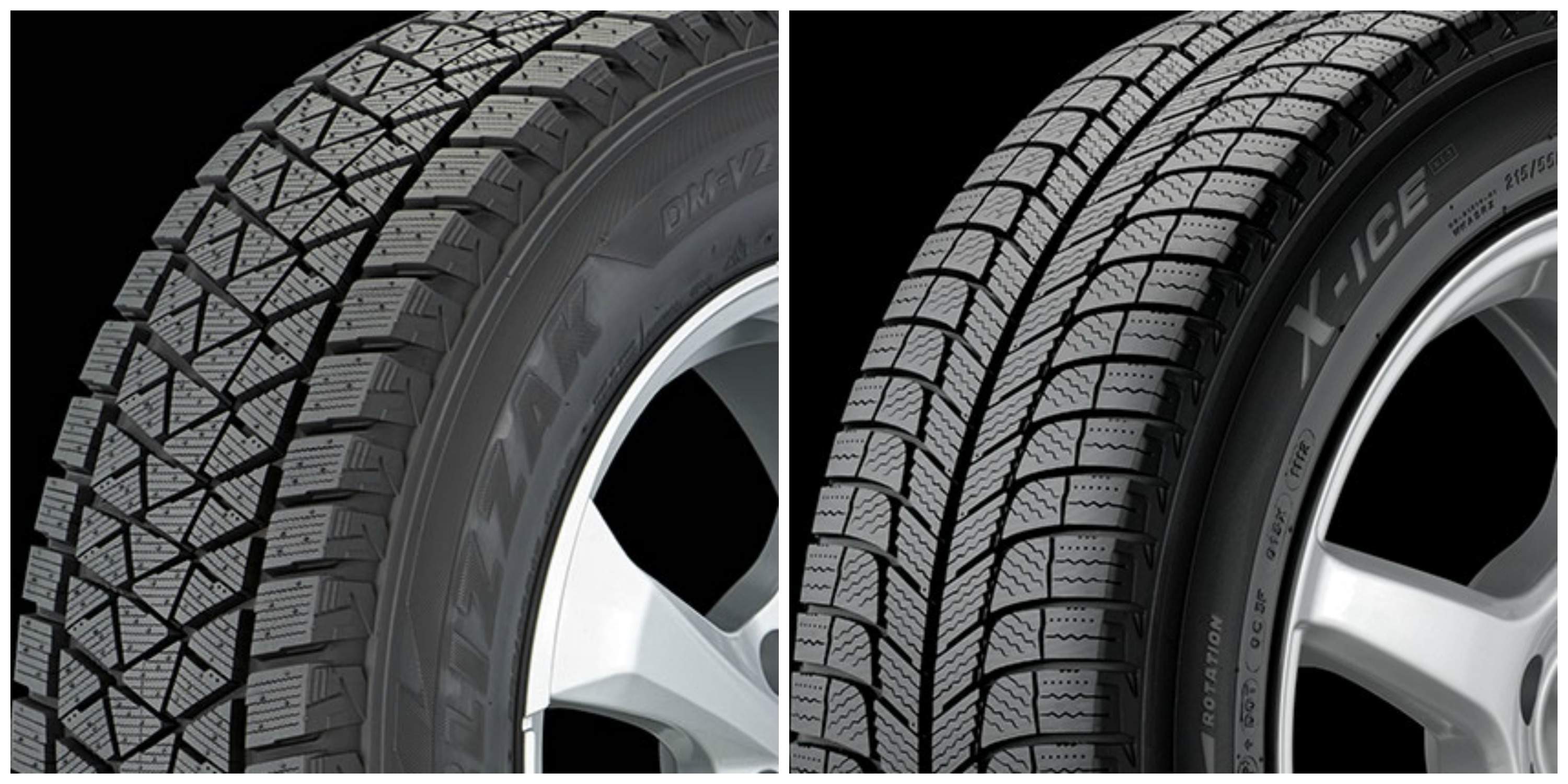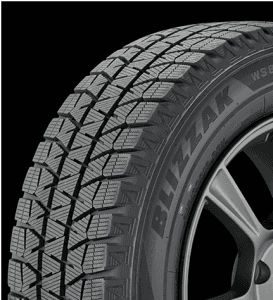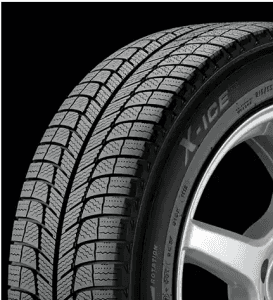Bridgestone Blizzak Vs. Michelin X-Ice
Whether you live in a place that is accustomed to severe winters or you go on cross-country drives often — chances are you have come across the idea of purchasing new winter tires.
A majority of cities in the United States see snow each year, so driving can be dangerous without proper tires.
Although many winter-tire options are available in the market, a few stand out from the rest due to their quality and longevity.
We pinned two of the top winter tires against each other to see which one is better. One is the Bridgestone Blizzak and the other is the Michelin X-Ice Xi-3.
The Bridgestone Blizzak and the Michelin X-Ice are probably two of the best winter tires you can buy. Be it performance, road grip, or longevity — both tires are meant to get you through this winter without a problem.
But which one should you go for? We tested out the tires. Read on to find out what we think.
The Bridgestone Blizzak
Bridgestone is renowned tire manufacturer known for its many tire series. The Bridgestone Blizzak WS80 is a popular model that further cements the company’s standing as a top-notch tire manufacturer.
The Bridgestone Blizzak WS80 is marketed as a studless winter tire, which is developed to make driving in extreme weather safe and enjoyable.
The WS80 was developed after the success of its predecessors. Vigorous tests were conducted in different driving conditions to ensure that the tire is an improvement from the earlier variant, the WS70.
Let’s start with the breakdown.
Product Information
The Bridgestone Blizzak WS80 makes use of the latest NanoPro-tech multicell compound used in tire manufacturing. The tread design of the WS80 sucks in and displaces water during rotations — which keeps the tire dry on wet tarmac.
The multicell compound has a hydrophilic coating and bite-sized gaps across the tread. The compound also allows the tire to remain flexible in varying temperatures.
We found the same to be true during our test drive on snowy roads. When tested, the vehicle equipped with WS80s had better grip — something all motorheads love!
The tire maintains maximum contact with the ground at all times. The design allows for all encountered forces to disperse evenly so you won’t feel any jerks during your drive.
The WS80’s shoulder blocks are smaller compared to the earlier variant. As a result, the tire has 20% more snow-biting edges and lug channels.
The tread blocks do not flex much in the tire because of the tire’s 3D zig-zag sipes — the zig-zag sipes are the reason behind the tire’s longevity, as Bridgestone claims.
To top it all, the Bridgestone Blizzak WS80 is stamped with the 3PMSF symbol – a quality symbol given to tires that have been tested in the harshest of weather conditions.
Our tests revealed that the WS80s offer better traction, more control over sharp turns, and decent braking capabilities — all the hallmarks of the Bridgestone Blizzak!
Pros
- Better grip
- Good traction
- A safe and comfortable driving experience
Cons
- Need to put the tire on all four wheels for best results
- Drive on dry surface is not as good
The Michelin X-Ice Xi-3
The specialized winter tires are developed by rival company, Michelin. And are the third iteration in its popular X-Ice series. The company claims that the X-Ice can perform well under harsh weather conditions.
The Michelin X-Ice is a direct competitor to Bridgestone’s Blizzak series. So what makes the Xi-3s special? The new cross z design or the self-locking technology. Let’s find out.
Product Information
The Michelin X-Ice Xi-3 is known for its braking capabilities on wet, slippery and icy surfaces. Michelin claims that a vehicle equipped with the Xi-3s stops in 10% less distance than other winter tires.
The tire uses Michelin’s own – Flex-Ice compound – in the X-Ice series. Winter tires are often known for their tread design. The Xi-3 has a unique design that makes it stand out among other winter tires.
The Cross z-sipes are meant to displace snow during tire rotations. The Xi-3 has tiny holes for water that form a vacuum — to suck in water and keep the tire dry.
Our test reveals that the Xi-3s help the vehicle stop quicker as compared to the Blizzak—something our test drivers attributed to the tread design.
So if you are a regular on the tracks and love to race the Xi-3 is for you!
The tire structure offers better handling and longevity. In our tests, the Xi-3 showed less wear and tear over time than the Blizzak. So the Xi-3s provide uncompromised winter performance for close to 37,200 miles — almost twice compared to other after-market tires.
More importantly, you can experience better fuel efficiency due to less rolling resistance.
Pros
- Better rolling resistance
- Better steering control and handling
- A noise free experience
- Treadwear is quite slow
- The tire runs well on dry surfaces
Cons
- The tire is a bit stiff so doesn’t perform well on bumpy roads
Difference Between The Two Tires
The WS80s already have a new variant in the market, the WS90. However, we believe that even the WS90 cannot match Xi-3’s longevity.
The Blizzak series is better than Xi-3s, in terms of grip and stability, at low and average speeds.
We feel the Blizzaks perform better in light rain and snowy conditions — but the Xi-3 is a clear winner in extremely harsh conditions.
The tread design of both tires is different. The Blizzak series has a more superior tread design, which allows maximum control of the vehicle.
The tread depth on the Blizzak provides a better grip on average speeds, but not so much at high speeds. The Xi-3, on the other hand, performs better at high-speed turns and offers good maneuverability to the driver.
Similarly, the Xi-3s had better braking capabilities as revealed in our tests. Although the WS80s are a fantastic winter tire they can’t be compared to the Xi-3s, in terms of performance.
The Xi-3 however only outperformed the Blizzak during high-speed tests. The Blizzak had better control at low speeds of up to 30 mph. Also, the Blizzak performed 33% better than the Xi-3 in acceleration and brake tests.
The cost might be a deciding factor when you set out to choose your tires. If you are on a budget, the Blizzak offers better value for money, while the Xi-3 provides better value in terms of longevity.
| Comparison* | ||
| Aspects | Bridgestone Blizzak WS80 | The Michelin X-Ice Xi-3 |
| Diameter | 24.9″ | 24.9″ |
| Width | 8.4″ | 8.4’’ |
| Rim Size | 16″ | 16’’ |
| Weight | 21 Lbs | 20 Lbs |
| Revolutions Per Mile | 837 | 836 |
| Maximum Load | 1356 Lbs | 1477 Lbs |
| Air Pressure | 44 PSI | 50 PSI |
| Tread Depth | 11/32″ | 10.5/32″ |
| Rim Width | 5.5-7.5″ | 5.5-7.5″ |
*= the comparison is based on a same-sized tire review for both brands.
What We Liked/ What We Didn’t
- The Xi-3 offers better long-term benefits and makes up for the lack of grip with better rolling resistance
- The deep snow traction offered by the Blizzak seems too good for the Xi-3 to trump
- The Blizzak aced the Xi-3 in acceleration tests due to its tread layout
- The Blizzak offers better quality in terms of price
- The Blizzak series is regularly updated with tweaks and new variants
- The Blizzak is available in 15-19 inch size, which fits most vehicles
- We were not impressed with the WS80s performance on dry surfaces
- The Xi-3 is a little pricey compared to the WS80s
- The Xi-3 did not perform well on bumpy roads
In Conclusion
It all depends on what you want to get out of your vehicle. We have done our best to highlight even the tiniest of difference we noticed in our tests. You can purchase either tire from a dealership near you!
The Blizzak series has around since 1993, and the company has made significant changes over time through research and testing. But the Xi-3 seems to stick with the same principles — with only minor tweaks over the years.
If you love your wheels and need performance go for the Xi-3. If you are looking for better value for money then the Blizzak series is your best friend!




Hi All.
I have a 2014 Highlander front wheel drive and I purchased Michelin X-ice Latitude winter tires. I don’t know if its the front wheel drive on my vehicle but I find the Michelins are horrible if you have any amount of snow or slush on the ground. I have had numerous close calls trying to pulling out into an interserection with just a little snow or slush with the Michelins. I would press on the gas to pull into the intersection and all I would get is the traction control light flashing like crazy and beeping at me. Luckily, people coming at me from the opposite direction were able to slow down until I was able to get any traction and pull out of the way. They must all have been driving with tires other than Michelins.
I hate the Michelin Latitude X-ice for snow and slush conditions. I am scared to drive in snow with these tires. Yes, they are quiet and have long life but I buy winter tires so I can get traction in the snow so I would sacrifice the quiet tires and some tire warranty to get winter tires so I don’t end up in the ditch. My other FWD vehicles all have Bridgestone Blizzaks and they drive through snowy and slushy conditions way better than the Michelins. I am not buying Michelin X-ice latitude ever again. They are horrible!
The Blizzaks are better than the Michelins or Nokians in Colorado. Blizzaks only last 3 winters max and really only have great grip for two…far better grip on ice and snow than the Michelins and even better than the good Nokians. The Nokians last longer- at least one winter. I will not bother with the Michelins again. They are not in the same class.
Thoughts? 2022 Ford Explorer ST AWD. I want to take the 275/45-21s off for the winter and use an 18 inch wheel for the winter. Thinking Blizzak 275/60-18 or X-Ice 285/60-18. A little worried about the X-Ice being a shade big. Winter use is a combination of around town and several long highway trips to the Upper Peninsula with two snowmobiles on a trailer. I am not likely to get stuck anywhere locally but who knows what kind of conditions I could run into while up North in sled country? …There are a lot of secondary type roads in the middle of nowhere required to get to the cabins.
My winter car is a 2019 awd-e Prius, and commute over a small mountain pass in western Canada.
The winter of 2019 I had Bridestone ws90s, and they were the best winter tire I’ve used, and I’ve had a few kinds (my favourite before the ws90 was the General Arctic Altimax); the traction on snow, ice, and in the rain was amazing.
My son needed winter tires so I gave the ws90s to him, and bought a set of out-going Michelin Xi3s to see the difference.
The Xi3s are a good winter tire, but are almost like an aggressive all-season compared to the ws90; the Michelin rolls easier, but is not as aggressive a winter tire as the ws90.
I have not tried the new Michelin X-Ice Snows.
I drove on both of these tires, & agree that both tires are good. To close between them depends on where your driving. If there’s a lot of snow on the ground, Blizzak are a definitely for you. I was surprised at how much better they were than the x-ice. If you drive on the highway, mostly cleared, you’ll enjoy the quiet and softer ride of the x-ice..
I like my Hakkapalita’s on my Jeep !
I just bought a set of michelin x ice xi3 on my honda accord, and love them. Tested them out in lake placid snow, and the recent storm in the northeast. They perform really well in snow, and are pretty quiet on dry roads. Previous snows were blizzak ws 80, and I feel I would give the nod to the michelins. So far a great tire
Do not buy blizzak I just had a set with 15k on them and completely worn out. I had xice last time over 100k and still good. I regret not buying another xice set instead of the blizzak. I am now buying g the xice snow to replace them.
Thank you for this comparison. I’ve been on the fence about which tire I want to purchase this year. I have the Blizzak WS-80’s and they were fantastic but very noisy. I think I will buy them again as I got a lot of mileage out of them. Not what it says they would get but still can’t complain. About 20,000 miles since 01/18/18 and today is 11/18/20. A longer lasting tire would be ideal.
Hi I tried all tyres on the market,they are good but nothing beats Nokia’s winter tyres so you know as this is coming from a mechanic and a consumer like me with self experience,thanks.
I agree with Sam!!! Nokian Hakka R3 is what I just put on my BMW. I’ve been running them on all my my cars for the past since 2006 and all I can say is they out perform anything on the market. Hands down. The R3 is the new release for Nokian (R2 was the predecessor) and I expect it to perform equally if not better than the R2.
weight will help, better winter tires in the winter rather than all weather will be better
Hi , thank you for your expert advice, I would like your recommendation for my 2019 Chrysler 300 RWD. I will be my first full winter, purchased in late March 2019, so practically no snow. Mind you I was caught by surprise, a little fishtail while taking off from work parking lot. It had firestone all season. Read on the net that rwd is very difficult to drive on snow, I’ve always had fwd , but this time I switched mainly because the car looks so nice and performs well in summer. Should I put weights in the trunk, I have leftover interlock stones…. Thank you in advance
Nokian Hakkapalita R3! You wont need extra weight in the back.